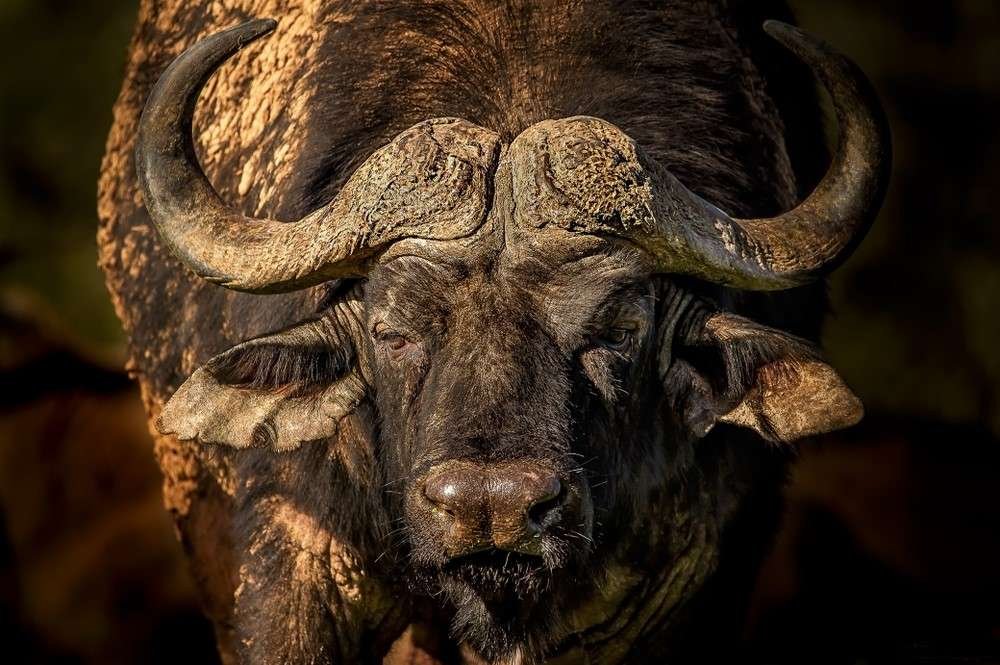African Buffalo
( mbowa, nali, munyati, the widowmaker, the black death )
- Syncerus caffer
- IUCN Status: Near Threatened
- Trend: decreasing

- Kingdom: Animalia
- Phylum: Chordata
- Class: Mammalia
- Order: Cetartiodactyla
- Family: Bovidae
- Subfamily: Bovinae
- Genus: Syncerus
Share:
General Information
The African buffalo is a very robust species and is one of the big five animals. It is Africa’s only wild cattle species. There are four subspecies of African buffalo and the largest is the Cape, or Southern Savannah (Syncerus caffer) which is found in Zambia.
Fun Facts!
African Buffalo’s vote! They have a communal practice of voting for which direction which they think the herd should move during migrations and it is not influenced at all by the dominant hierarchy. They make a decision by choosing the direction that the majority of female buffalo face while they sit and rest. Another infamous fact is that hunters have given these unpredictable beasts the name of, ‘the Widow-maker’ especially being that it is at its most dangerous when wounded.
Description
- Shoulder height: 1.7 metres
- Length: 2.1 – 3.4 metres
- Weight: 300 – 900 kgs
- Lifespan: 26 years
Ecology and Behaviour
Buffalo are hierarchical and gregarious, living in large herds which can consist of many hundred individuals consisting of females, their young and dominant bulls. Adult bulls determine dominance by sparring with larger and older bulls to claim dominance, although violent fights are rare. Young males form smaller herds and old males leave their herd for a more solitary existence. They spend most of the day lying down in the shade to escape the heat, drinking water in the early morning and cooler afternoons and grazing and browsing at night. The herd will travel to find food, preferring to graze on fresh grass, but will browse on herbs, shrubs and trees when grasses are not available.
Buffalo communicate through low-pitched calls. Mothers call to their calf with a croaking sound, and a calf responds with a higher pitched croak. They make a variety of noises when grazing, with bellows, grunts honks and croaks which are thought to help keep a herd moving in the same direction. When threatened they make a drawn out ‘waaaa’. They also make submissive and defensive displays, tossing their heads, using a stiff-legged walk and rubbing their horns on the ground.
Females normally give birth to a single calf, during the rainy season. The bond between a mother and her calf is very strong and within a few hours a new-born calf is able to keep up with its herd although they are usually hidden in dense vegetation for their first two weeks. Calves are kept at the center of the herd for protection and are weaned at about 11 months although they may stay with their mother until they are three years old.
Buffalo live in a range of habitats, including open woodland savanna with abundant grass and access to drinking water, montane grasslands and forests and lowland rain forests.
Herds will stampede when alarmed and old males can be extremely dangerous when threatened. If the herd is threatened by predators, they will surround their young and aggressively defend their herd, stampeding the attacker. They are also known to rescue captured individuals. Herds can outrun their attacker with old solitary bulls being more prone to be taken by lions. New born calves are also preyed upon by cheetah, leopard and spotted hyena.
Conservation
African buffalo are classified as Near Threatened on the IUCN Red List.
Distribution and Habitat
Buffalo are a key species – they play an important ecological role due to their grazing which opens up areas of long grassland for other herbivores who have a more selective feeding habit. The African buffalo is one of the most successful grazers in Africa. It lives in savannas, swamps and floodplains, as well as mopane grasslands, and the forests of the major mountains of Africa. This buffalo prefers a habitat with dense cover, such as reeds and thickets, but can also be found in open woodland. While not particularly demanding in regard to habitat, they require water daily, and so they depend on perennial sources of water. Like the plains zebra, the buffalo can live on tall, coarse grasses. Herds of buffalo mow down grasses and make way for more selective grazers. When feeding, the buffalo makes use of its tongue and wide incisor row to eat grass more quickly than most other African herbivores. Buffaloes do not stay on trampled or depleted areas for long.
Interaction with humans
In some countries buffalos are also known as “the Black Death” or “the widowmaker”, and are widely regarded as a very dangerous animals with wounded animals reported to ambush and attack pursuers. They kill more than half of the people that attack them and buffalo related deaths come very close to hippo and crocodile annual related deaths.
No donation to this project yet.
| M | T | W | T | F | S | S |
|---|---|---|---|---|---|---|
| 1 | 2 | 3 | 4 | 5 | 6 | 7 |
| 8 | 9 | 10 | 11 | 12 | 13 | 14 |
| 15 | 16 | 17 | 18 | 19 | 20 | 21 |
| 22 | 23 | 24 | 25 | 26 | 27 | 28 |
| 29 | 30 | 31 | ||||


